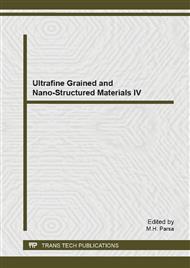p.20
p.25
p.30
p.36
p.41
p.46
p.52
p.57
p.62
Effect of Rubber Modification on the Morphology and Properties of Novolac Nanostructures
Abstract:
Nanostructured organic materials have received considerable attention over the past decade. This nanostructure is responsible for their unusual acoustic, thermal, and mechanical properties. One of the most studying of this field is sol-gel polymerization of resorcinol-formaldehyde, followed by organic solvent exchange, supercritical drying. However, the conventional process involves long gelation time, expensive monomer of resorcinol, high cost of supercritical drying device and so on, which makes it some distance away from being promoted to commercial production. In this work, to reduce cost and time, the reaction of novolac resin and hexamine and ambient pressure drying method was used for preparation and drying of organic gel. To reduce time, the polymerization in saturated atmosphere of solvent vapor instead of conventional sol-gel polymerization presented. These nanostructure materials have a nanoporous structure that constructed by colloidal like particles gathered up in filament-shaped. Because of this nanoporosity and structure, these materials have very low fracture energy and could including them as brittle materials. The goal of this research produces these nanostructure materials using novel method and enhances fractural resistance. To gain this proposes, the feasibility of using acrylonitrilebutadiene rubbers (NBR) has been investigated. For studying of morphology and properties of this structure, we used SEM, FTIR and porosimetry analysis. The results shows that the addition of 0.5, 1 and 2 wt% NBR to Novolac nanostructure increased density and decrease the pore volume and pore size.
Info:
Periodical:
Pages:
41-45
Citation:
Online since:
November 2013
Authors:
Keywords:
Price:
Сopyright:
© 2014 Trans Tech Publications Ltd. All Rights Reserved
Share:
Citation:


